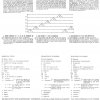Pianophonie
Pianophonie for piano, electronic transformation of sound and orchestra (1979)
Szábolcs Esztényi – piano, Polish Radio and TV Symphony Orchestra, cond. Stanisław Wisłocki, electronic: Experimentalstudio der Henrich-Strobel-Stiftung des Südwestfunks, "Warsaw Autumn" 1979
{slider=Pianophonie for piano with electronic transformation of sound and orchestra /excerpt/}
Szábolcs Esztényi – piano, Polish Radio and TV Symphony Orchestra, cond. Stanisław Wisłocki, "Warsaw Autumn" 1979
{/slider}
Big boxes are shining in the spotlight on the stage of the National Philharmonic Hall decorated with flags. The piano is standing in the middle – “plastered” with microphones. Cables stretch from the stage on the floor of the auditorium as far as the console desk in the centre of the room, with Hans Peter Haller from the Electronic Studio in Freiburg behind it.
This is how Sztandar Młodych reported the world premiere of Kazimierz Serocki’s “Symphony for piano” at the inaugural concert of the 23rd “Warsaw Autumn” in 1979. The work was commissioned by the Südwestfunk Radio (SWR) in Baden-Baden and the electronic music studio of the Heinrich Strobel Foundation in Freiburg. The composer spent a lot of time in the studio, thoroughly testing the capabilities of the available electronic equipment.
We know how the work on the piece looked from Hans Peter Haller’s account:
In the first stage of the preparations [Serocki – I.L.] tested the sonic capabilities of the ring modulator, experimenting on the piano with two modulators and four oscillators. He went home with a “package” of sound structures and composed Pianophonie, using his newly-discovered sound material. A few weeks later he returned to the studio to test his composition for piano and live electronics, and to correct it. In addition, we talked to the composer about notating electronic transformation of sound in the score.
[...] From the very beginning the composer deliberately used live electronics only for the piano solo in order to – on the one hand – develop the piano sound and define a palette of useful functions of its transformation and, on the other – to achieve additional contrast with the original sound of the orchestra.
[...] For the two remaining oscillators [e.g. those assigned to the sound engineer – I.L.] a special double oscillator was designed, an oscillator that could implement graphic playing instructions notated by the composer (e.g. diagonal glissandi). [...] With this concept Serocki was able to achieve a fourfold transposition of piano sound, an additional delay in superimposing the layers and a broad spectrum scope – from melodious piano sounds to complex noise.
Thus, the role of electronics in Pianophonie involved only transformation of sounds generated by the piano, by which microphones were installed. They captured sound, while special devices transformed them “live”. These were: four oscillators, two ring modulators, two delaying devices, a set of filters, and amplifiers. In addition, devices used during the work’s performance included the so-called halaphone – a device designed by the first director of the Freiburg studio, Hans Peter Haller (HA(ller)+LA(wo)+PHONE). It made it possible to simulate sound movement in space. The entire set was controlled by four people: a sound engineer, two technicians and the pianist himself. All intensities, transformations and deformations of sounds were precisely notated in the score.
As it is, the piano part in Pianophonie involves not just ordinary playing the keyboard, but also – as in Serocki’s earlier piano works – generating sounds directly on the strings: pizzicato, glissando or using sticks with tips of varying hardness and width.
The work is divided into seven parts. From the first three there emerges varied sound material which then develops only to return in something that resembles a classic reprise. Despite the fact that the whole piece is designed on such a monumental scale, when it is heard, it is very clear and sounds almost like a chamber work. It includes scherzo-like fragments, aggressive discharges and sprayed sound “clouds” as well as clearly delineated rhythmic passages. There is also room – as in a traditional concerto – for a solo cadenza of sorts. The cadenza has unique properties achieved thanks to specific sound correlations (band-pass filters) that emphasise canonic repetitions contained in it.
There is a huge build-up of expression and sonic beauty in Pianophonie. The work is deservedly regarded as Serocki’s greatest achievement, opening new paths in his work, paths which, however, he was unable to follow because of his untimely death.
{slider=Sources:}
- Tadeusz A. Zieliński, O twórczości Kazimierza Serockiego [On Kazimierz Serocki’s Oeuvre], Kraków 1985.
- Hans Peter Haller, Lehrhefte: Funktion und Anwendung: Heft 3 – Klangtransposition, online.
{/slider}











